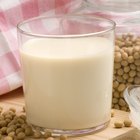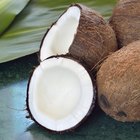
GYRO PHOTOGRAPHY/amanaimagesRF/amana images/Getty Images
While soy lecithin is derived from soya, there are some key differences that set them apart. The beans retrieved from pod of the soya plant are referred to as soya, according to a report from the Chiropractic Research Organization. Once harvested, the soya is turned into a myriad of food products such as oil, tofu and milk. These products usually require some type of processing, but the properties of the soya bean remain largely unchanged. Soy lecithin is a waste product left after producing soya oil. Lecithin is a collection of several phospholipids that have both health and industrial uses.
Protein
Soya contains a large fraction of protein that is mostly removed from soy lecithin, according to the University of Nebraska's Food Allergy Research and Resource Program. Protein from soya is considered one of the few “complete proteins” that comes from a source other than meat, fish or dairy. When all of the essential amino acids necessary for biological function are present in a food it is referred to as a complete protein. For a protein to be considered complete, it must also have those amino acids in the correct proportions. Because soy lecithin is extracted from the processed oil of the soya bean’s shell, it contains little of this protein.
Antioxidants
Soya beans and its products contain several different antioxidants that soy lecithin does not. Antioxidants are compounds that stop the oxidation of other molecules, a process which can damage healthy cells by releasing free radicals. These free radicals can cause runaway reactions within the body that may result in further cellular damage. This damage may include killing the cell or destroying its DNA, possibly causing cancer, according to the National Cancer Institute. Studies show that sufficient levels of antioxidants reduce the risk of heart disease and other conditions.
Choline
While it may lack antioxidants and protein, soy lecithin does contain a substance known as choline. Choline is a micronutrient that has been designated as an essential nutrient. Choline also plays a major role in the formation of cell walls. Without the phospholipids created with the help of choline, the walls would not be able to become loose enough for other nutrients to pass through. This nutrient is vital for lipid-cholesterol metabolism in the cell, in addition to many other functions. Choline is also thought to play a role in preventing cardiovascular disease, cancer and Alzheimer’s disease, according to the Linus Pauling Institute.
Soy Allergies
One of soy lecithin’s main differences is how people with soy allergies react to it. Most people with soy allergies show a reaction when exposed to different forms of soy. Because soy lecithin is a processed byproduct of the soya bean, the hot solvent used to extract it typically removes the compounds that trigger the allergic reaction, according to the University of Nebraska's Food Allergy Research and Resource Program. While it is possible for it to contain some leftover soy protein, soy lecithin is considered safe for people with soy allergies to consume.
Related Articles

Is Soy Milk Casein-Free?

Burt's Bees Ingredient List

Cold Pressed vs. Expeller Pressed

Substitute for Gram or Besan Flour

Composition of Monosodium Glutamate

What Are the Benefits of Extrapone ...

Is Allantoin a Relative of the Lanolin ...

What Is Clear Liquid Coconut Oil?

How to Make Soy Milk With Defatted Soy ...

What Is 916 in Jewelry?

What Makes Homemade Chai Curdle?

What Is Glycerine Used For?

Properties of Bentonite Magmas

Chocolate and Vitamins

What Is the Nutritional Value of Wheat?

Nutrition and Protein in Rice

Coconut Oil Extraction Methods

Cappuccino Nutrition Information

Whole Milk Vs. Lactaid Milk

Is Jasmine Rice Naturally White or Is ...
References
- Cleveland Clinic: Soy Allergy
- Chiropractic Resource Organization: What is Soya?
- MedlinePlus.com: Soy
- British Journal of Nutrition: Cholesterol-lowering Effects of Soyabean Lecithin
- Linus Pauling Institute: Choline
- National Cancer Institute: Antioxidants and Cancer Prevention
- University of Nebraska Food Allergy Research and Resource Program: Soybeans and Soy Lecithin
Writer Bio
A native of New Orleans, Derek Brown is a professional jeweler and jewelry designer with a passion for writing. He holds a Bachelor of Science in biological engineering from Louisiana State University.
Photo Credits
GYRO PHOTOGRAPHY/amanaimagesRF/amana images/Getty Images